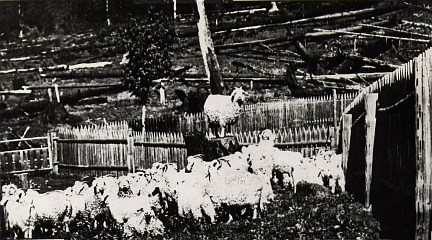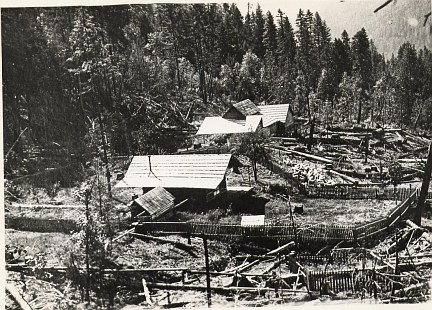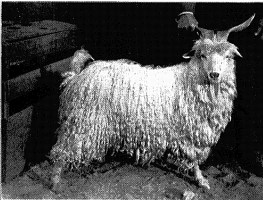~~* Black Sheep Newsletter............Issue 119............Spring 2004 1998 *~~
 †
†
THE HOMESTEAD: Echoes From the Past, Picket Fences, A Short History
ECHOES FROM THE PAST
The internet has been a friend to my husband and I a few times. On occasion, just out of the clear blue, our e mail program will contain a real gem of a letter, sometimes from someone we've never met. This happened to us in July of 2003. Here's where my true saga begins.![]()
We must first, though, start at the very beginning - twelve years or so ago - when Stan and I first moved to this rugged mountain town in Oregon's southern Cascade mountain range. We were new here and fixing up the old place, hammers in hand. At the same time we were trying to fix the dilapidated house that came with the land, we were starting our Oregon herd of angora goats. The herd was slowly increasing goat by goat, the angora goats and their mohair again happily in our lives. You see, we had earlier packed up and left Montana behind, and in doing so, had to sell our previous herd. We had missed them much.![]()
Our new abode, Drew, Oregon, was quite a friendly town. It helped, of course, that our small new home was situated right on the big highway that runs from the small town of Tiller, finally snaking over the mountain pass to Trail. So, it was likely that folks would stop by to satisfy their own curiosity as to who we were and what we were attempting to do in these parts. If they were stockmen at all, their lands had for decades been used to fatten cattle. They were cattlemen and women, the goats being a strange breed to them. Their curiosity was piqued and they'd pull their lumbering pick ups into our driveway to give their welcome and then ask their questions.![]()
After introducing themselves and letting us know how many centuries their families had been here, they'd take a gander at our new spread. One couldn't miss the shaggy haired goats in full view behind newly erected fences, mohair gleaming in the sunshine with all the luster it's known for. And from these new neighbors came the first stories of another herd of angora goats that lived in these mountains so long ago.![]()
I don't recall now which local first approached the subject of that herd of goats from times past. It may have been Ralph Stauch, a cattle rancher who had worked clearing mountain roads on muleback in the old days. I can still hear the rather soft voice coming from a stout man who always wore a crumpled cowboy hat. His tone was gracious, the words he chose always refined.![]()
"You have angora goats there, I see. You know, in the early part of this century (it was 1993 when this conversation occurred) a big herd of angora goats lived in these mountains." His eyes scanned mountain horizons. "A man whose last name was Jaques." Ralph said the name like the French would, with a silent "s" on the end. It rhymed with "rock."![]()
We asked him a lot of questions about those goats because of our love for the animal (as well as a penchant for old history.) As it turned out, however, neither Ralph nor any of the others who remembered stories of the Jaques goats knew too much about them. After all, this was some 90 years or more later. All anyone seemed to know was that this was once goat country - Angora goat country, to be exact.![]()
Another neighbor sauntered up the country driveway one day, the dust kicking up under his heels. He, too, talked about those "old goats of Drew, old man Jaques' goats" telling us that the museum keeper in this small community had once shown him a lock of mohair all braided up and set nicely behind glass. "Said it was mohair from one of those goats." That came our way after someone else had said that Mr. Jaques actually braided the mohair on his goats so that it wouldn't collect briars and thistles as the goats browsed. That seemed a bit far-fetched to us, but we listened with rapt attention.![]()
Another told us about the Drew goats of long ago: "Those long braids of mohair hung nearly to the ground." These were my new country neighbors and each one seemed to remember something of those long ago goats![]()
In time the stories stopped coming. Though we never discovered what was truly fact and what was speculation, what was hear-say or memories passed down from generation to generation, we knew that in the early 1900's an angora goat herd roamed these very mountainsides. I felt rather amazed by the coincidence of it all and sensed a strange "connection" to this man I'd never met, Mr. Lott Jaques, who with his band of goats, lived way before my time. Lott Jaques and his goats made his home amidst these very same forests, rock outcroppings and wide green fields that we did.![]()
The years rolled forward one by one and we continued to accumulate angora goats on the place. Soon enough they were dropping kids on the ground, and those kids grew up soon enough until our herd was a large one. Being smitten by the beauty of colored mohair, we soon brought in a few colored angora goats. By then we'd forgotten all about the Jaques homestead -- that is until the last week of July, 2003 when we received an auspicous e mail.![]()
It began:
If you do not mind I will shoot you a few questions. My bona fides are that my father with his brother homesteaded probably at the head of the creek your falls are on, if it is Joe Hall Creek.![]()
We were at attention by then, of course. The writer continued.![]()
When I tune you and your goats in, I think of Lott Jaques, who raised mohair champions on above Chuck, back about 100 years ago. I have a couple of pictures of his goats, none of him. He was a fine wood worker from New England. I do not scan, but have our daughter do so and forward to me, and thus am able to send pictures. Just checked, I think she already has the goat pics, so I just need to get her to send them. I hope this is the case. Most of the pictures from that day belonged to my cousin, and now reside with her daughter, who is by now over 90.![]()
Our correspondent had a signature of Robert Wright. We learned soon enough that he preferred to be simply called "Zeke" and that his boyhood home was not too far from us. His old boyhood haunts were actually a few miles down the road, a small outlying town called Milo.![]()
That day his e mail arrived we excitedly answered him in the affirmative. Yes indeed, we were very interested in seeing some of those old pictures of the old "J-Q" (what some had been calling Mr. Jaques) place and those goats we had heard so much about. After pitching and batting e mails back and forth for awhile, in about two weeks' time Zeke Wright wrote us saying that sadly enough those old goat pictures could not be located. It seemed for a short time it was not to be after all![]()
Then again out of the clear blue our computer's mailbox revived with another missive from Mr. Wright. His daughter, it seems, had found two old photographs of the Lott Jaques homestead and his goats.![]()

The Herd of Lot Jacque
The Lott Jaques homestead pictured here. The time would be around 1907. If one peruses the history of the angora goat in America, one finds that by this date every state in the union had angora goats. Texas, Oregon, New Mexico, and California held the largest numbers of goats in those early years. In 1907 the American mohair industry was burgeoning, mohair a much coveted commodity. It was shipped to the industrial centers where the big looms turned out mohair "plushes" which lined railroad passenger cars as well as trolley cars and upholstered fine American furniture.![]()
FENCES MADE FROM PICKETS
The old adage "a picture says 1,000 words" certainly came true for me that day those two incredible photographs came to us from the Wright family photo archives. My husband and I marveled when we viewed them, for we could readily see some of Lott Jaques' hard labors by viewing the old photos. Some would see a lot of strewn timber lying about the place. We saw clearings where an untamed forest had been cut away, making room for a herd of goats. We looked hard at the fences that had been erected, made from pickets.![]()

The Lot Jaque Homestead
"He cut thousands of pickets - enough to enclose 60 acres," another of our neighbors told us later. My jaw dropped at that statement. I know what it's like to string fence and even with T posts and ready made lumber and wire, it's no easy task. This same neighbor had been up to the old Jaques homestead a few times and said a few of those pickets could still be found lying on the ground haphazardly, remnants of a long ago homestead, echoes from the past.![]()
Mr. Jaques died in 1921 county records show. But if he were alive today I'd ask him a multitude of questions about a time in history when mohair was a coveted fiber and the industry was moving forward at a quick pace. And when I could catch him in a good mood, I'd ask him if he truly did braid all that goat hair on his animals like they say, or if that was just another Oregon myth.![]()
Our thanks to Zeke Wright and his daughter, Margaret Wright, for the use of the photos.![]()
HISTORY OF THE AMERICAN ANGORA GOAT (IN A NUTSHELL)
My husband and I came across the most interesting book about a year ago entitled A Manual of Angora Goat Raising published in 1903 by the American Sheep Breeder Co. Press. Written by George F. Thompson, it compiles information about the Angora goat - from its hidden beginnings in Asia Minor (Turkey) to its long journey across the continents and finally to America. It is fascinating reading to those like myself who love the animals and the fiber they produce, and can't read enough about them.![]()
During the early 1900s, when Lott Jaques made his abode in these mountains, the mohair industry in America was a burgeoning one. Mohair was very much in demand at the time - the mechanized looms turning out "mohair plush." The fashion industry was interested in mohair, also, mohair woven into a fine fabric known simply as "brilliantine." The luster found in mohair coupled with its durability (it was found to be three times stronger than wool) made it a coveted product in every way.![]()
By 1907 every state in the union had Angora goats. A census (published 1899) shows the total angora goat population in the United States at that time with Texas holding the largest population. Oregon came in strong in second place, while California trailed third in the line-up. The average value per pound (for the whole country) for mohair at the time was 27.8 cents. We've "come a long way, baby" as the saying goes, but of course we must recall that dollar values change also.![]()
Time has fast-forwarded and today the market for American mohair isn't what it used to be. Folks like us are catering more to the handspinners' market, a very small niche in the economy. Railroad passenger cars no longer are lined with lustrous mohair plush. Acrylic threads have taken over upholstery looms. Brilliantine is an antiquated fabric from long ago days and can't be found in fabric stores.![]()
I gaze at the old photos of a quaint mountain homestead, circa 1907, and wonder if perhaps in the midst of that circle of white goats one or two were direct descendents of the great Grand Champion Angora goat buck, Aztec (pictured below):
Champion Aztec (1902) bred by D.C. Taylor and sold to Kemble Bros., Muscatine, Iowa, for $1,400, the highest price ever paid for an American bred Angora.![]()
It's interesting to note what Mr. Thompson says about Champion Aztec in his manual:
"$1,050 was paid for Columbia Pasha at the Kansas City Goat Show (1901) and $1,400 for Aztec in 1902, principally because of their freedom from kemp. It is true that their fleeces were fine and long and their bodies were fully covered, but the appearance of the animals as they stood in the pen (their size and carriage), although they were "good lookers", had comparatively little weight with the judges, who gave to them the sweepstake prize as the best bucks of all ages in the show."![]()
So, at this year's Black Sheep Gathering there will be another Angora Goat Show (an event I so look forward to) and that goat judge will again scrutinize fleeces. Perhaps that's where the phrase "with a fine toothed comb" originated - with mohair judges. Times have not changed quite that much after all, I muse to myself. Kemp on an angora goat was anathema 100 years ago, and continues to be.![]()

Aztec 1902 champion
We must applaud the Columbia Pashas and the Aztecs of our own time, and behind the scenes those careful breeders who spend their lives perfecting the animal. Each year these goats only get better and better.![]()
Well, we've got our own herd of Angoras to feed and I'm already late with their grain rations. I'd better make a mad dash for the barn, or as mad a dash as this old body will do. We'll shear a few more goats today, the weather warm and balmy as summertime - so rare for mid-March. The fleeces are sumptuous, and so little kemp. It all makes me wonder just what brilliantine looked like...![]()
Alexandra Scribe
Homestead Home
TOP






